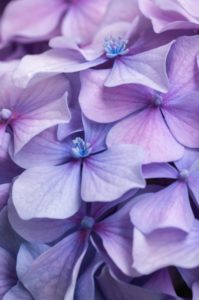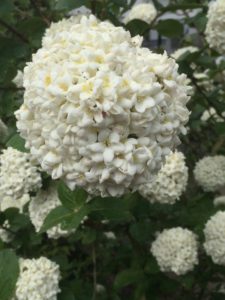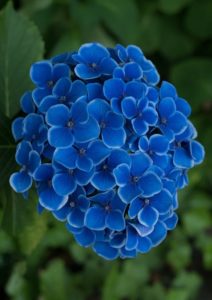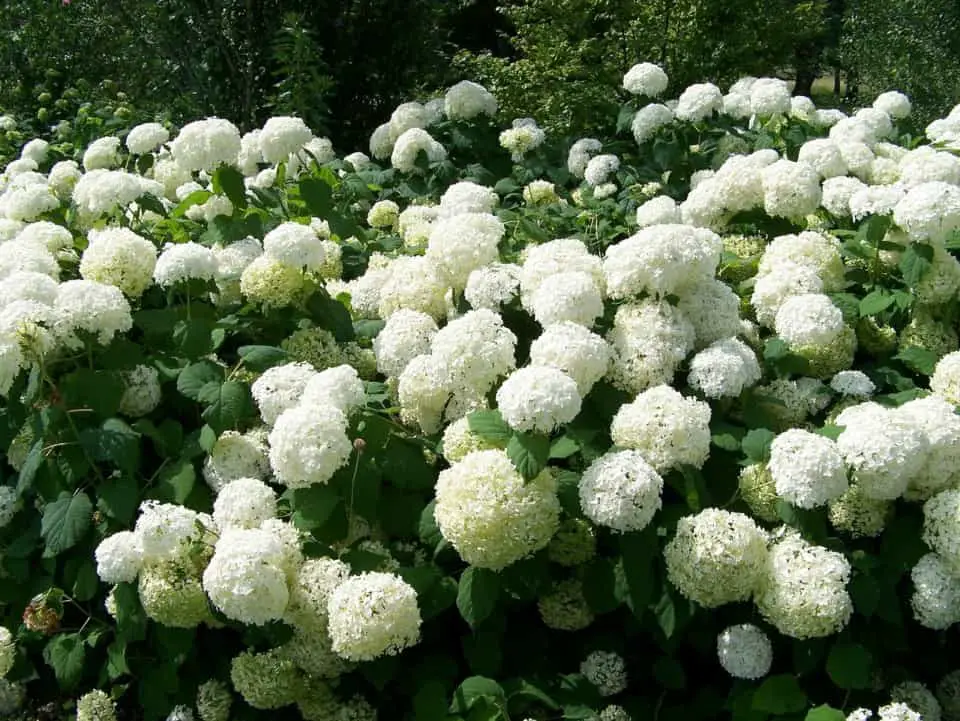Some links in the post are affiliate links and I get a commission from purchases made through some links found in the post.
Snowball bush and Hydrangea are commonly confused together. They are both small and deciduous shrubs that look pretty similar. However, there are a lot of differences that can help you differentiate between them.
Snowball bush is a member of the Viburnum opulus plant species found in Europe and Western and Southern Asia. It gets its name because of the beautiful white flowers that it produces in the spring season.
This vast, diverse group includes more than 150 species of plants. Most of them show glossy and dull green foliage with contrasting pale undersides. However, there are a few species with splashy, mottled leaves.
Hydrangea is also very similar to the snowball bush in appearance. The word Hydrangea is a Greek word, meaning “water vessel”.
Its old name, Hortense, is a French word given in honor of a French astronomer, Nicole-Reine Hortense Lepaute. It has a lot of different varieties, each producing unique colored flower heads in the spring season.
Let us dive deep and see the main differences between the two plants.
The hydrangea grows well in partial shade but can grow in full sun with extra care whereas the snowball bush naturally grows in full sun to partial shade.
The hydrangea is a low-maintenance plant whereas the snowball bush is susceptible to many organisms like bacteria, fungi, pests, and nematodes.
Snowball Bush Vs Hydrangea – What is Their Appearance and Structure

A hydrangea can grow up to 3 to 5 feet tall and wide. Its branches grow in a loose and widely spaced-out form.
It has toothed leaves and shallow veins. It blooms from June through September, and its flowers have different colors.
Whereas a snowball bush is famous for its large white flowers. Initially, the color of the flower is apple-green, then it changes to white and then eventually into rose color.
It is a fast-growing shrub that has dark emerald-green color. This 3-inch cluster of flowers is followed by red-colored berries that ripen into black color.
The leaves of the snowball bush turn reddish-orange in fall, making it a perfect specimen plant for spring or fall. It reaches a height of 6-10 ft and a width of 6-12 ft when it matures.
Snowball Bush Vs Hydrangea – What are Their Preferred Growing Conditions
Hydrangea
It needs well-draining, nutritionally average soil with a medium level of watering every few weeks. The hydrangea grows best in partial shade and can also grow in full sun with regular watering. It cannot tolerate drought conditions.
There is a loss of leaves during the winter season, and in extreme winters, the plant can die. It needs to be pruned to the ground level in the late winters both to encourage renewed and strong stem growth and to remove weaker stems.
The hydrangea makes a good hedge as long as it does not lose its leaves in the winter season. It looks good in a naturalized woodland garden setting.
Snowball Bush
The snowball bush viburnum grows best in full sunlight. Six-hour sunlight a day is adequate to produce large masses of flowers. However, a location with a partial shade that is consistently warmer is suitable for gardeners to grow it.
This plant prefers well-drained and loamy soil, but it does not need to be too specific. It can grow in a variety of soil conditions. It can also tolerate different pH ranges but prefers to grow in acidic soil.
Watering the soil consistently is vital to allow the plant to reach its maximum potential. It prefers moist soil. A schedule of 1 inch per week is adequate.
But in dry and warmer conditions, more water is required. The moisture in the soil can be maintained by applying mulch around the shrub, and it will have the beneficial effect of suppressing the weeds.
Snowball bush can tolerate freezing winters of zone 6 and warm summers of zone 8. Anything above or below this cannot be tolerated. It can thrive in both dry and wet conditions, provided the air circulation and the soil drainage are adequate.
Fertilize the plant with a slow-release fertilizer in the spring season. Avoid using a fertilizer with excess nitrogen and avoid contact with the shrub, as both are harmful.
If you are enjoying this article, check out our article on hydrangeas vs rhododendrons.
Snowball Bush Vs Hydrangea – What Pests and Diseases Affect Them?
Hydrangeas
Hydrangea is a low-maintenance plant, and it has no serious diseases. But a few diseases are common in it, like leaf spot, mold, wilt, and pests like aphids, mites, scales, and nematodes.
In the presence of favorable growth conditions, if the plant is not growing, it means that the plant is suffering from a disease.
Snowball Bush
On the other hand the snowball bush is susceptible to many organisms like bacteria, fungi, pests, and nematodes.
Bacterial leaf spots and powdery mildew are detrimental conditions for the plant. They are also susceptible to aphids. Therefore, organic insecticides like neem oil should be applied as soon as the disease is confirmed.
Viburnum crown borer is a wood-boring insect that causes the stem to die back to the ground level.
It can destroy the whole plant. A beneficial nematode (Heterohabditis bacteriophora) can be applied as a soil drench, and it can prevent the plant from being destroyed by the wood-boring insect.
Chemical pesticides can also be applied on the lower bark that can prevent the insect from gaining a foothold.
Powdery mildew is an unattractive and fatal fungal disease that produces white powder on the plant that are its spores.
Allowing maximum air circulation and watering at the ground level instead of watering it overhead can prevent the disease from occurring.
In addition, remove the debris around the plant at the end of the season, preventing it from overwintering and spreading the spores in the following spring season.
Chemical pesticides should be applied as soon as the disease is diagnosed.
Leaf spots are usually seen on random areas, which is the feature of a bacterial disease.
Unfortunately, there is no cure for this infection, so the diseased plant should be removed. Also, develop the habit of cleaning the pruning instruments regularly.
Snowball Bush Vs Hydrangea – Varieties
Hydrangea

It has many varieties. The most distinct variety of Hydrangea is “Anabelle”.
Other varieties include “Sterilis” (Hydrangea arborescens), which has flatter flower heads and a lacy appearance because of few showy sterile flowers.
“Green Knight” (Hydrangea arborescens) has round and white flower heads that eventually turn to dark green.
It also has varieties based on the color of the flowers. Hydrangea macrophylla and Hydrangea serrata have flowers ranging from purple to pink.
The color depends on the acidity or alkalinity of the soil. Acidic soil imparts a blue color to the flowers, whereas alkaline soil imparts a pink tint.
Snowball Bush
Following are some closely related snowball type hybrids of viburnum:
Cayuga viburnum is a cross between V.carlessi and V. carlcephalum. It has a compact growth habit (4-10 ft tall and wide) and blooms profusely with a 4-inch white cluster of flowers in the spring season.
Judd viburnum (V. juddii) is a cross between V. carlessi and V. bitchiunse and is a very attractive shrub that is hardy in zone 4 to 8. It is also resistant to bacterial infection and is easy to propagate.
Snowball Bush Vs Hydrangea – What is the Pruning Procedure
Hydrangea
Initially, perform minor pruning immediately after the flowering to tidy up the plant. Snip just below the dead blooms with sharp pruning shears.
Thorough pruning is done either in the fall as the shrub enters the dormancy or in the winter season when it begins to put on new growth in the spring season.
Cut down any diseased or dead part of the plant with the pruner’s blade. Afterward, clean the blades with the help of alcohol.
Trim the stems that are crossing and are present at an awkward angle. Cut the stems back to the site where the two leaves meet.
Rejuvenate the older plant by cutting the oldest stem up to the ground level. Removing up to one-third of the stem in this manner stimulates new growth.
If the height of the plant is to be controlled, then cut the tallest stem up to the ground level. It may change the natural appearance of the plant.
Snowball Bush
Prune just after the flowering period is over, and prune it lightly. It can also be pruned if it has to be used in hedge applications.
If they are not used for the floral displays, pinch off the spent blossoms to encourage new growth.
When necessary, this shrub will tolerate the hard pruning to the ground level as a means for renovating the plant.
Snowball Bush Vs Hydrangea – Caring in Spring Season
Hydrangea
Feeding: Water the hydrangea plant well before and after feeding the plant. A general-purpose fertilizer with a ratio of 10:10:10 is suitable for an equal growth of roots, foliage, and flowers.
If the fertile soil promotes the development of shrubs, then only low-nitrogen fertilizer with a ratio of 7:9:5 is adequate for the growth of flowers.
2 cups of fertilizer per 100 square feet are adequate, and it should be spread evenly over the whole ground. Care should be taken while applying the fertilizer as fertilizer can burn the shrub if it comes into contact with it.
We have an article on how to make a natural fertilizer for your hydrangea.
Pruning: Pruning is primarily done in the spring season, regardless of the variety of the
Hydrangea because there is no growth in the autumn season, and the plant enters the dormancy period and will not produce any new growth until the following spring season.
Snowball Bush – Planting

Dig a hole as deep as the root but two to three times wider. Fill the gap with the removed soil, with the root crown remaining 2 inches above the soil level. Water the newly planted bush well and place mulch around it, about 4 inches deep.
When selecting the location, make sure that it has adequate space and sunlight. Fertilization once per year is sufficient, and pruning is optional.
Before you go, here are some more related articles I encourage you to read below to help solve more of your gardening issues:
How do you get Rid of Black Spots on Hydrangea Leaves
Why Are My Hydrangea Leaves Curling
Why are my Hydrangeas Turning Green
About the Author:
Saad Ansar
Saad is an avid gardener himself and is a great lover of plants, animals, photography, & people. Currently, he is focused on photographing indoor plants & captioning beautiful outdoor sceneries. In addition, he writes and rewrites in-depth articles on nature and science.


